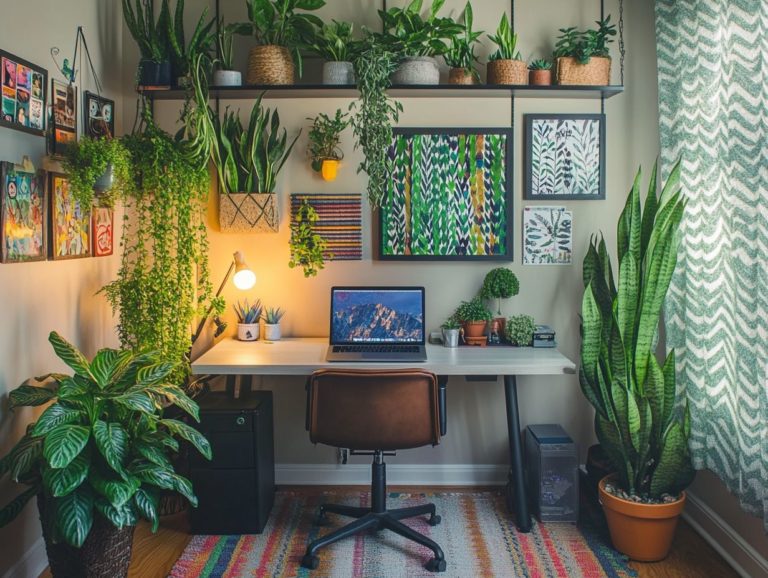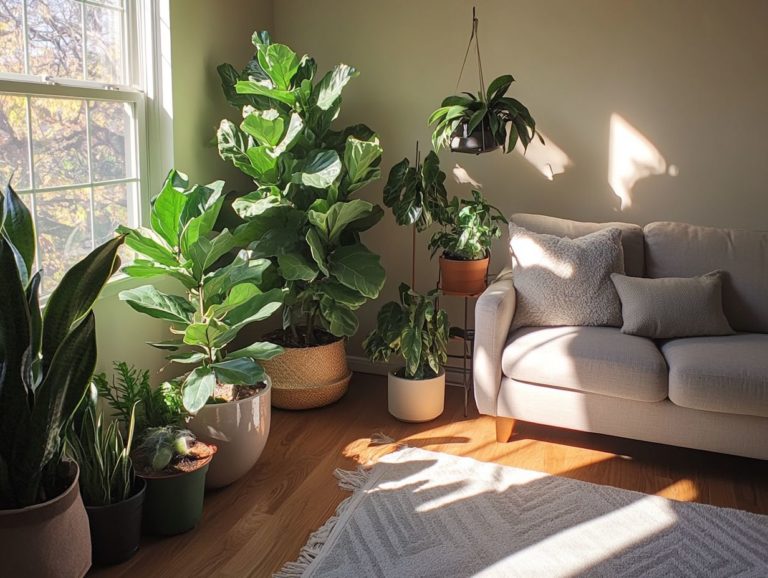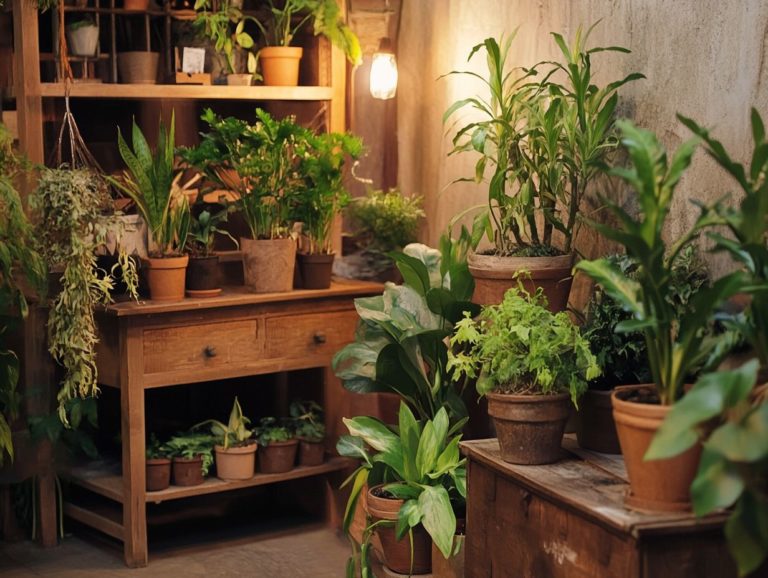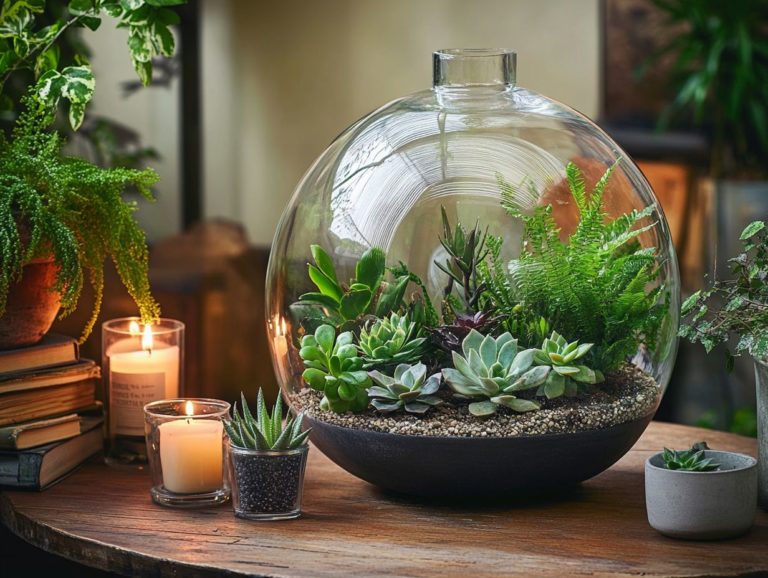Using Indoor Plants to Purify Your Air
Indoor air quality is paramount to your overall health, yet it often goes unnoticed in the hustle and bustle of daily life. This is especially true given the prevalent air pollution in many urban environments.
When air quality suffers, the consequences can be far-reaching, leading to a host of health issues. However, the presence of indoor plants, such as snake plants and peace lilies, can be a game changer in addressing this concern.
Get ready to discover how houseplants can transform your indoor air into a breath of fresh air! This article showcases the remarkable ability of houseplants to purify the air, highlights the best species for eliminating toxins, and provides valuable tips for nurturing your green companions to enhance indoor air quality.
Uncover how crafting a healthier indoor environment, including green walls and proper ventilation systems, can elevate your well-being and effectively combat specific air pollutants with the right botanical allies.
Contents
- Key Takeaways:
- The Importance of Indoor Air Quality
- How Indoor Plants Improve Air Quality
- Best Plants for Indoor Air Purification
- How to Care for Indoor Plants
- Creating a Healthy Indoor Environment
- Using Plants to Combat Specific Air Pollutants
- Frequently Asked Questions
- What are the benefits of using indoor plants to purify your air?
- What types of indoor plants are best for purifying air?
- How many plants do I need to purify the air in a room?
- Can I use artificial plants to purify my air?
- Do indoor plants need special care to stay effective in purifying air?
- Can indoor plants help with allergies?
Key Takeaways:
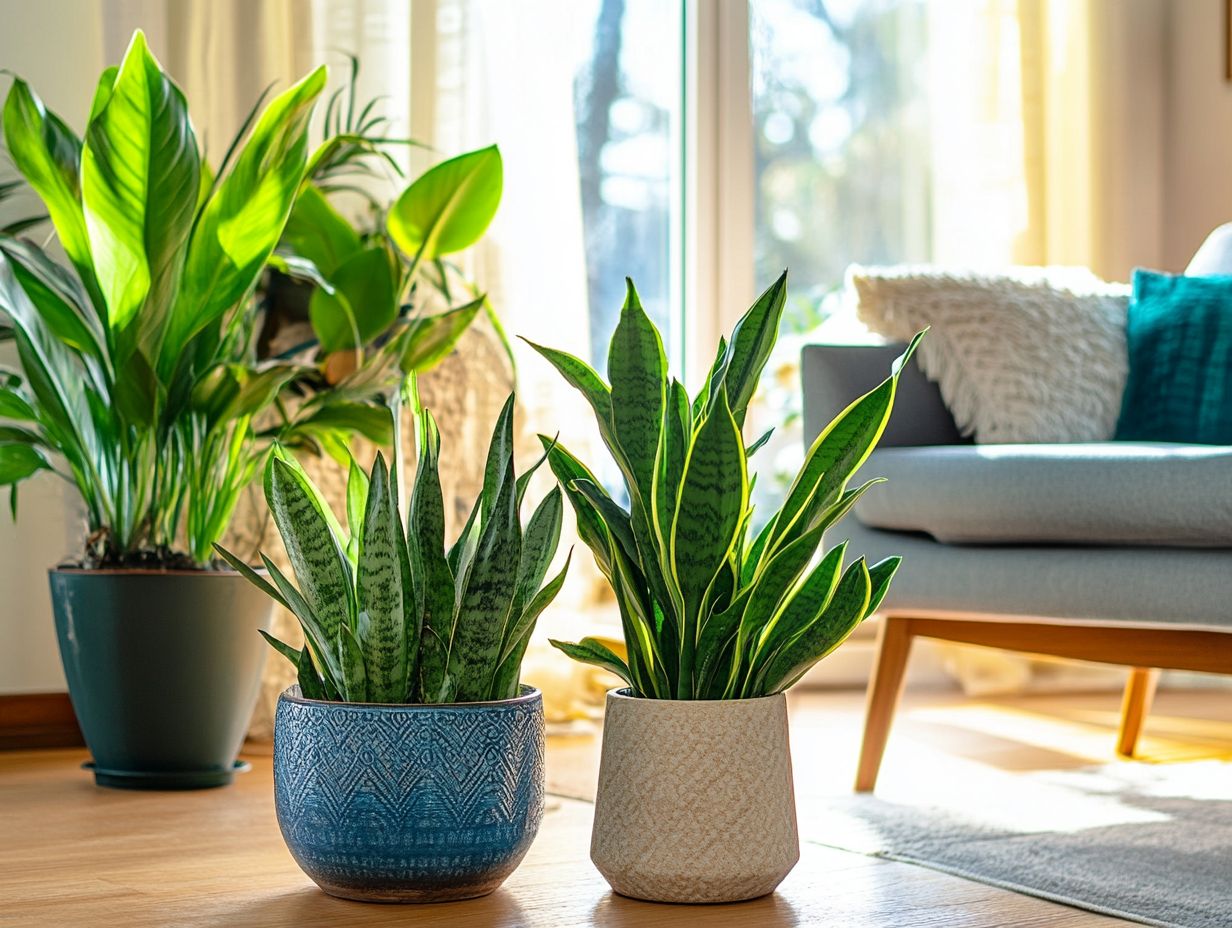
- Breathing clean air is crucial for our health, and indoor plants can help purify the air we breathe.
- Certain plants have proven abilities to remove toxins and pollutants from indoor air, making them excellent natural air purifiers.
- Proper care and maintenance of indoor plants are essential for maximizing their air purifying benefits and creating a healthy indoor environment.
The Importance of Indoor Air Quality
Indoor air quality (IAQ) is vital for your overall health and well-being, especially considering how much time you spend indoors. When air quality suffers, it can lead to heightened levels of pollution, which are often worsened by harmful gases that come from household products like paint and cleaners.
This can result in concerning health issues, including respiratory diseases. Understanding indoor air quality is essential, particularly in the wake of the COVID-19 pandemic, where the need for clean air has reached unprecedented importance.
The WELL Building Standard highlights the need for excellent indoor air quality to support environmental health.
Health Impacts of Poor Air Quality
Poor indoor air quality poses serious health risks that can impact your respiratory system and overall well-being. Prolonged exposure to unhealthy air can lead to respiratory diseases, which have gained significant attention, especially in the wake of COVID-19.
The pandemic has increased awareness of how airborne contaminants like mold spores, harmful gases, and particulate matter contribute to health issues, particularly in confined spaces. If you have pre-existing conditions such as asthma or chronic obstructive pulmonary disease (COPD), the danger of severe complications increases when indoor air quality suffers.
Research indicates that even those without existing health issues can experience worsened symptoms from pollutants. This underscores a universal vulnerability to the effects of indoor air quality. As a result, many are now prioritizing air purification solutions and improving ventilation to mitigate these risks and protect their health.
How Indoor Plants Improve Air Quality
Indoor plants act as natural air purifiers, elevating your indoor air quality by efficiently removing a range of toxins and pollutants. A NASA study reveals that certain houseplants can dramatically decrease harmful substances in the air, such as formaldehyde and benzene, through a fascinating process called phytoremediation.
These plants not only purify the air but also enhance the overall aesthetic of your living space, creating a healthier and more inviting environment for you to enjoy.
Start incorporating indoor plants into your home today for better air quality!
The Science Behind Plant Purification
The science behind plant purification resides in their remarkable ability to filter air and absorb harmful chemicals (VOCs are harmful chemicals released by some household items). This process is significantly enhanced by the micro-organisms in the soil.
By introducing houseplants into your space, you can effectively reduce levels of VOCs and other toxins. To enhance this effect, consider learning about the best indoor plants for air quality, which elevates indoor air quality and promotes a healthier environment.
These micro-organisms play a critical role, breaking down toxic compounds such as formaldehyde, benzene, and xylene, which are often emitted from everyday household items, including paints, cleaners, and furnishings. As your plants engage in photosynthesis (the process plants use to make their food and release oxygen), they absorb these harmful chemicals through their leaves and roots.
The interaction between the plants and soil-dwelling microbes fosters a symbiotic relationship. The microbes supply essential nutrients to the plants while simultaneously decomposing harmful substances. Incorporating a variety of houseplants into your home can dramatically enhance air quality and lead to improved respiratory health.
Best Plants for Indoor Air Purification
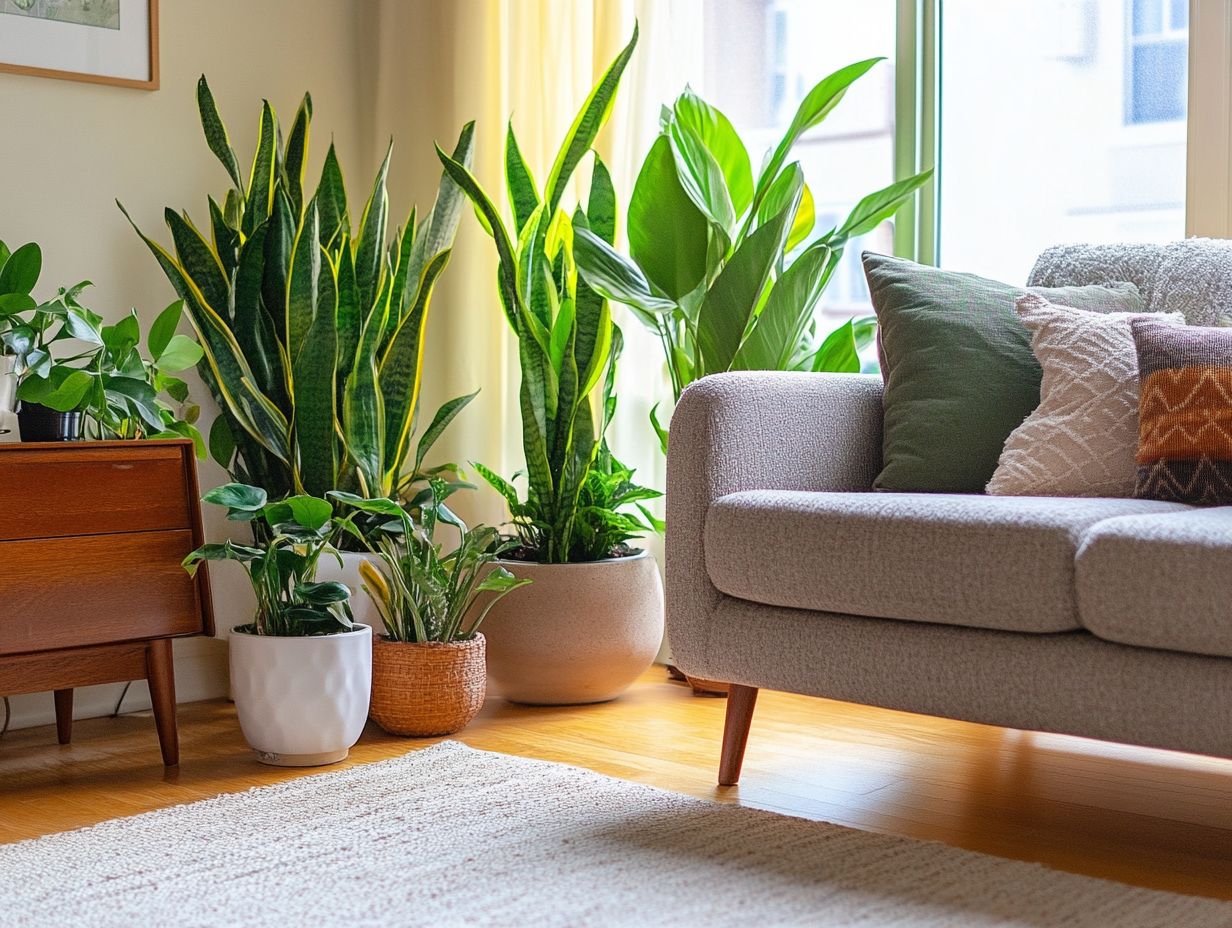
When selecting plants for indoor air purification, some species excel in filtering toxins and enhancing air quality more than others. Consider incorporating plants like the snake plant, spider plant, and peace lily into your space.
These amazing plants are champions at removing indoor pollutants, and they are also low-maintenance, making them perfect for elevating air quality in your home or office. To learn more about the benefits of having indoor plants, start transforming your indoor environment today!
Top Plants for Removing Toxins and Pollutants
Top indoor plants for removing toxins and pollutants include species renowned for their prowess in tackling formaldehyde and absorbing benzene and trichloroethylene. For instance, the Boston fern and English ivy are celebrated for their effectiveness in filtering these harmful substances.
These plants are prime candidates for elevating your indoor air quality. Peace lilies flourish in low light, deftly combating formaldehyde while also absorbing carbon monoxide and other irritants.
Spider plants are another exceptional choice. Known for their resilience and lively growth, they effectively capture airborne toxins like benzene and xylene. By incorporating these remarkable plants into your living spaces, you can harness their unique abilities to foster a healthier environment.
All while infusing a touch of greenery and style into your interior decor. As these plants photosynthesize, they not only purify the air but also elevate the overall atmosphere of your home and office.
How to Care for Indoor Plants
Caring for your indoor plants is crucial for their longevity and effectiveness in purifying the air. This involves understanding the optimal light conditions and humidity levels they require.
By implementing proper maintenance practices and recognizing the specific needs of low-light plants, you can significantly enhance the vibrancy of your indoor garden.
Tips for Maintaining Healthy Plants
Maintaining healthy indoor plants requires your dedicated attention to several key aspects. These include proper watering, selecting the right type of fertilizer, and regular pruning to encourage robust growth.
Implementing effective pest control measures is equally vital to protect your plants from harmful infestations that could jeopardize their health. To ensure effective watering, develop a schedule tailored to each plant s specific needs.
Consider factors like humidity levels and seasonal changes when watering. Choosing a balanced, slow-release fertilizer will provide essential nutrients throughout the growing season.
Grasping the unique requirements of different species is crucial. Mastering pruning techniques fosters bushier growth and allows you to remove any dead or diseased leaves.
In terms of pest control, integrating natural remedies like neem oil or insecticidal soap can create a safer environment for both your plants and your home. This will help you maintain a thriving indoor garden.
Creating a Healthy Indoor Environment
Creating a healthy indoor environment goes beyond simply placing a few indoor plants around; it demands a holistic approach that includes effective ventilation and careful management of indoor humidity.
By prioritizing optimal air quality, you enhance the comfort of your space and pave the way for energy cost savings, making your environment more efficient and inviting.
Other Factors to Consider for Clean Air
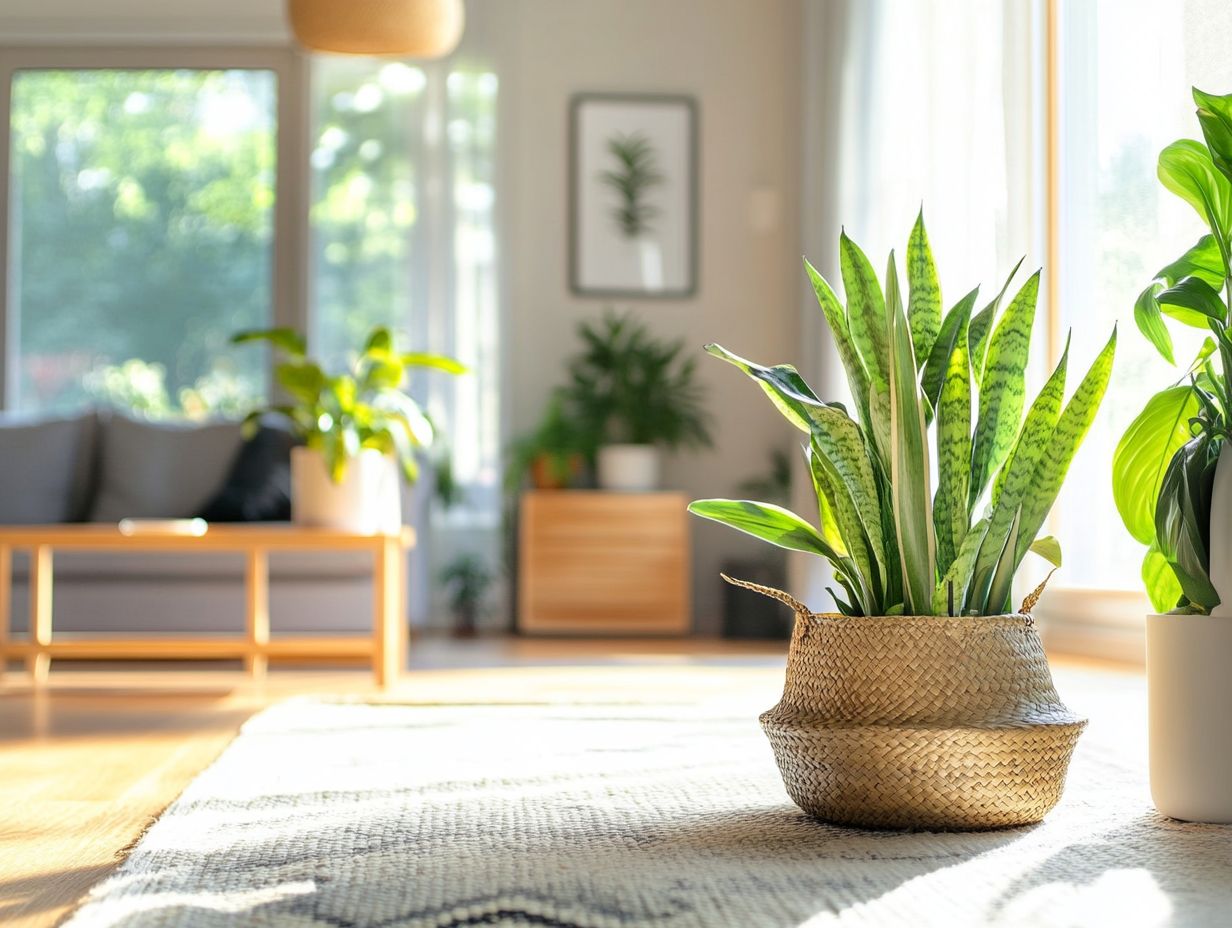
Incorporating indoor plants is just one part of maintaining clean air. Other crucial factors include effective ventilation and environmentally conscious practices. Understanding how these elements interconnect can significantly enhance your indoor air quality and lower your energy costs.
Proper ventilation is essential. It circulates fresh air while expelling pollutants and excess humidity that could jeopardize your health. Alongside your vibrant indoor greenery, use exhaust fans and regularly maintain your HVAC systems to improve air circulation and overall quality.
Start reducing harsh chemicals today for a healthier home! Actively identifying and managing common sources of indoor pollution contributes to a healthier living space. Together, these strategies create a more inviting indoor atmosphere and support broader environmental health efforts.
Using Plants to Combat Specific Air Pollutants
Utilizing specific indoor plants can effectively combat air pollutants by directly targeting the toxins that often invade your living spaces. For instance, certain varieties excel at removing formaldehyde, while others absorb benzene and trichloroethylene.
This showcases the remarkable potential of plants in enhancing air quality and creating a healthier environment.
Targeting Specific Toxins with Plants
Targeting specific toxins with plants can significantly elevate your indoor air quality. Certain species, like the spider plant and peace lily, excel at tackling common indoor air contaminants. Their unique abilities are often amplified by beneficial fungi in the soil that help plants absorb nutrients.
For example, the spider plant can absorb formaldehyde and xylene, often lurking in paints and plastics. Meanwhile, the peace lily efficiently combats ammonia, a compound typically released from cleaning products and fertilizers.
These plants thrive in harmony with specific microorganisms, enhancing nutrient uptake and boosting the plants’ detoxification processes.
By cultivating an optimal ecosystem for these plants, you embrace a natural method to reduce indoor pollution, resulting in healthier living spaces and an overall improved sense of well-being.
Frequently Asked Questions
Got questions about using plants to purify your air? We’ve got answers!
What are the benefits of using indoor plants to purify your air?
Using indoor plants to purify your air has many benefits, such as improving air quality, reducing toxins, and adding natural beauty to your home or office space.
What types of indoor plants are best for purifying air?
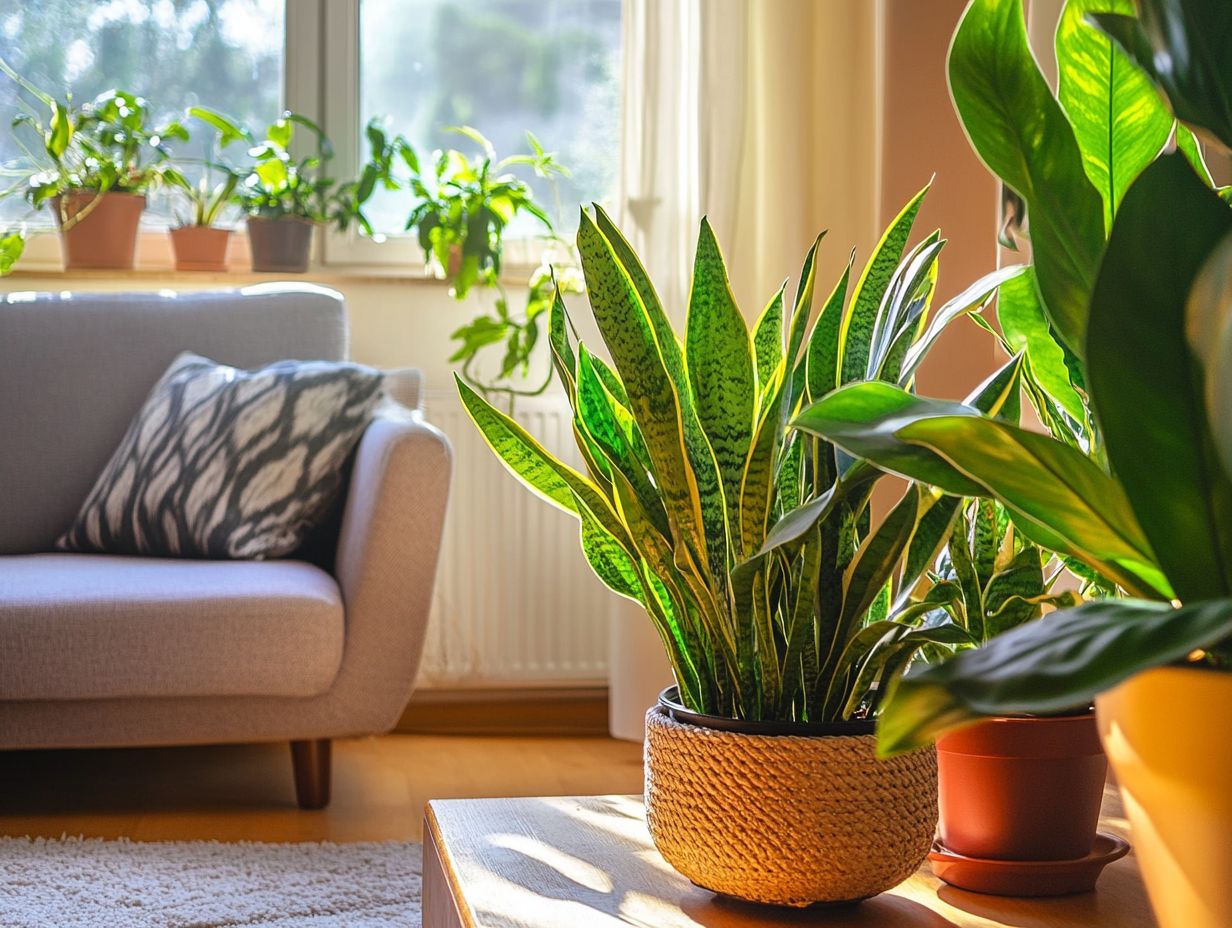
Some of the best indoor plants for purifying air include spider plants, peace lilies, snake plants, pothos, and bamboo palm. These plants are known for their ability to remove toxins and produce oxygen.
How many plants do I need to purify the air in a room?
The number of plants needed to purify the air in a room depends on the room’s size and the type of plants used. As a general rule, one medium-sized plant per 100 square feet is recommended.
Can I use artificial plants to purify my air?
No, artificial plants do not have the same air purifying abilities as real plants. They do not produce oxygen or remove toxins from the air, making them ineffective for purifying air.
Start your journey to cleaner air today by choosing the right indoor plants!
Do indoor plants need special care to stay effective in purifying air?
Yes! Indoor plants require regular watering and enough sunlight to purify the air effectively. You should also clean their leaves to remove dust and debris.
Can indoor plants help with allergies?
Absolutely! Plants like spider plants and peace lilies can reduce allergens in the air. Just remember, some people may be allergic to specific plants, so research your options carefully.

